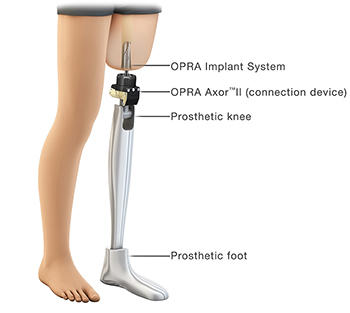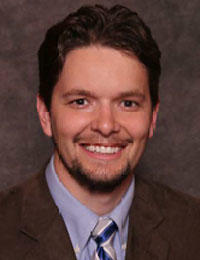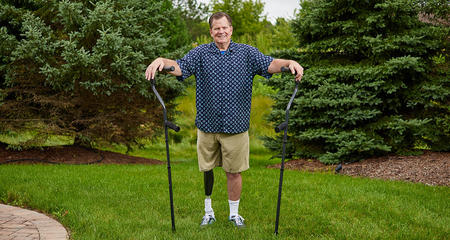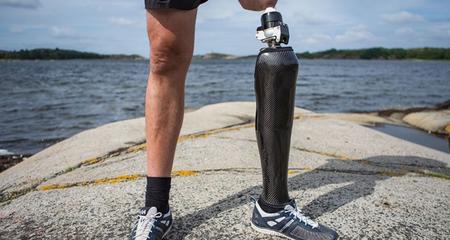The Osseointegrated Prostheses for the Rehabilitation of Amputees (OPRA) Implant System is intended for use in patients with above-knee limb amputations due to trauma or cancer. It is also designed for those who have rehabilitation problems with a classic lower-limb prosthetic, for individual complications or who cannot use a regular artificial leg prosthesis. You may also be a good candidate for the OPRA Implant System if you have high levels of pain when wearing your artificial leg prosthesis or skin problems from wearing your socket prosthesis.
The OPRA Implant system is intended for daily use. However, you will need to complete the training program before you can use your prosthesis for long periods of time. You should discuss your daily activities with your physician to make sure they can be done safely with this device.
How the OPRA Implant System Works
The OPRA Implant System consists of seven titanium or titanium-alloy parts that are implanted during two surgeries. These parts allow a prosthetic leg to attach directly to the femur (thigh bone).

In the first surgery (Stage 1), the fixture is implanted in the femur (thigh bone). Healing time for this surgery is about 6 months. During this time, the bone grows onto the fixture to anchor it in the femur. Your hospital stay will last 1 to 3 days, and you will be discharged with the appointments you need before the second surgery. Physical therapy is not needed during the 6-month recovery period. Immobilization is preferred in order to optimize healing.
After the healing is complete, the abutment is attached to the fixture in your second surgery. The abutment extends outside the skin to attach to the prosthetic limb. Again, your hospital stay will be 1 to 3 days, and you’ll be discharged with appointments in place, including virtual visits for convenience. After 6 months, you will be ready to start rehabilitation with the prosthetic leg.
See how the OPRA Implant System helped a double amputee.
The OPRA Axor Prosthetic Limb

The OPRA Axor prosthetic leg attaches to the abutment outside of the skin installed in the second surgery. It acts as a safety connection between the implant and the prosthesis. It is designed to prevent damage if the implant is overloaded. If an overload occurs, the Axor twists the prosthesis to protect the implant from damage.
The OPRA Axor must be installed and serviced by a professional who specializes in prostheses. That person will also adjust the release level to meet your needs. You should never change the settings yourself. The OPRA Implant System may be used in combination with the recommended parts only, and according to the instructions.
The OPRA Rehabilitation Process
You must not put full weight on the prosthetic leg for at least 6 months after the first surgery. Putting full weight on it is normally allowed about 6 months after the second surgery, after a check-up by the treatment physician.
A physical therapist will work with you through your individual mobilization and physical therapy program. The initial period of rehabilitation uses a short training prosthesis to “load” the implant, starting with movement with no weight on the prosthesis and gradually adding weight until the prosthesis supports your full body weight.
During the program, we will evaluate your progress and any pain you experience to determine if it is safe to move to the next levels that include a full-length prosthesis and greater range of motion.
Who Can Get the OPRA Implant
The OPRA Implant System is currently approved by the FDA and intended for use in patients with above knee amputations due to trauma or cancer. It is also designed for those who have rehabilitation problems with a classic prosthetic, for individual complications, or who cannot use a regular artificial leg prosthesis. You may also be a good candidate for the OPRA Implant System if you have high levels of pain when wearing your artificial leg prosthesis, or skin problems from wearing your socket prosthesis.
Optimal candidates for the OPRA Implant System meet the following guidelines.
- Bone growth is complete, based on X-rays.
- Bone structure is typical with no abnormalities such as deformities, fractures, infection or osteoporosis.
- You are between the ages of 22 and 65.
- Body weight is less than 220 pounds, including the prosthesis.
- You are not pregnant.
- You are able to follow your treatment plan and adhere to device guidelines.
Some diseases may also affect your treatment, including peripheral vascular (blood vessels outside the brain and heart), poorly controlled diabetes, immunosuppression, skin disorders near the stump, neuropathy, active infection or dormant bacteria.
Potential OPRA Implant System Risks
Like all surgical procedures, the OPRA treatment has certain risks, which might lead to poor results. Incorrect use such as failure to follow and complete the required training, excessive activity that overloads the device or injuries such as falls will increase the risks.
Inspect the device daily. Some patients report infection, pain, injury and mechanical complications. If any of these complications occur, they must be treated right away. Infections can be serious and may require long-term antibiotic treatment or removal of the device. Complications such as loosening of an implant or bone infection may occur over the long-term use of the system, so contact your physician right away if you notice any signs of infection, leakage from the implant area changes in the way the prosthetic connection feels.
The parts of the OPRA Implant System can be replaced if they wear or break. Long-term success of the OPRA system has not yet been established, so there is a risk that all of the parts would have to be removed and that the stump would need to be shortened another 4 inches.



